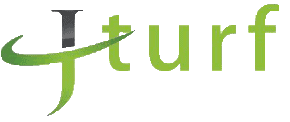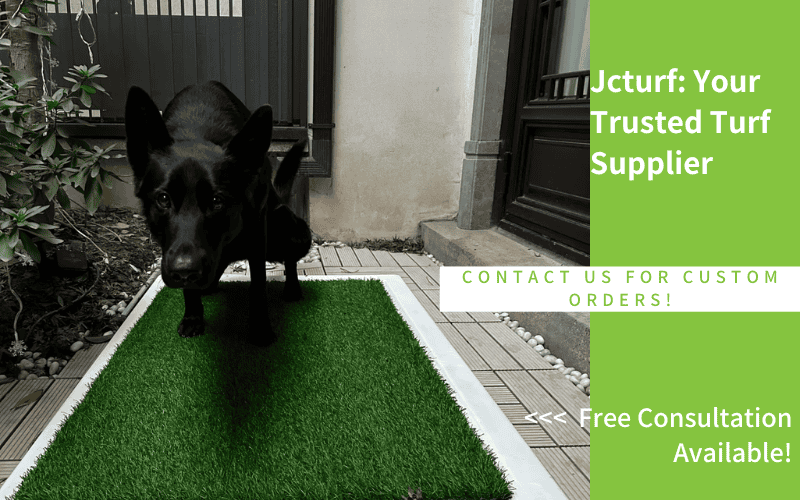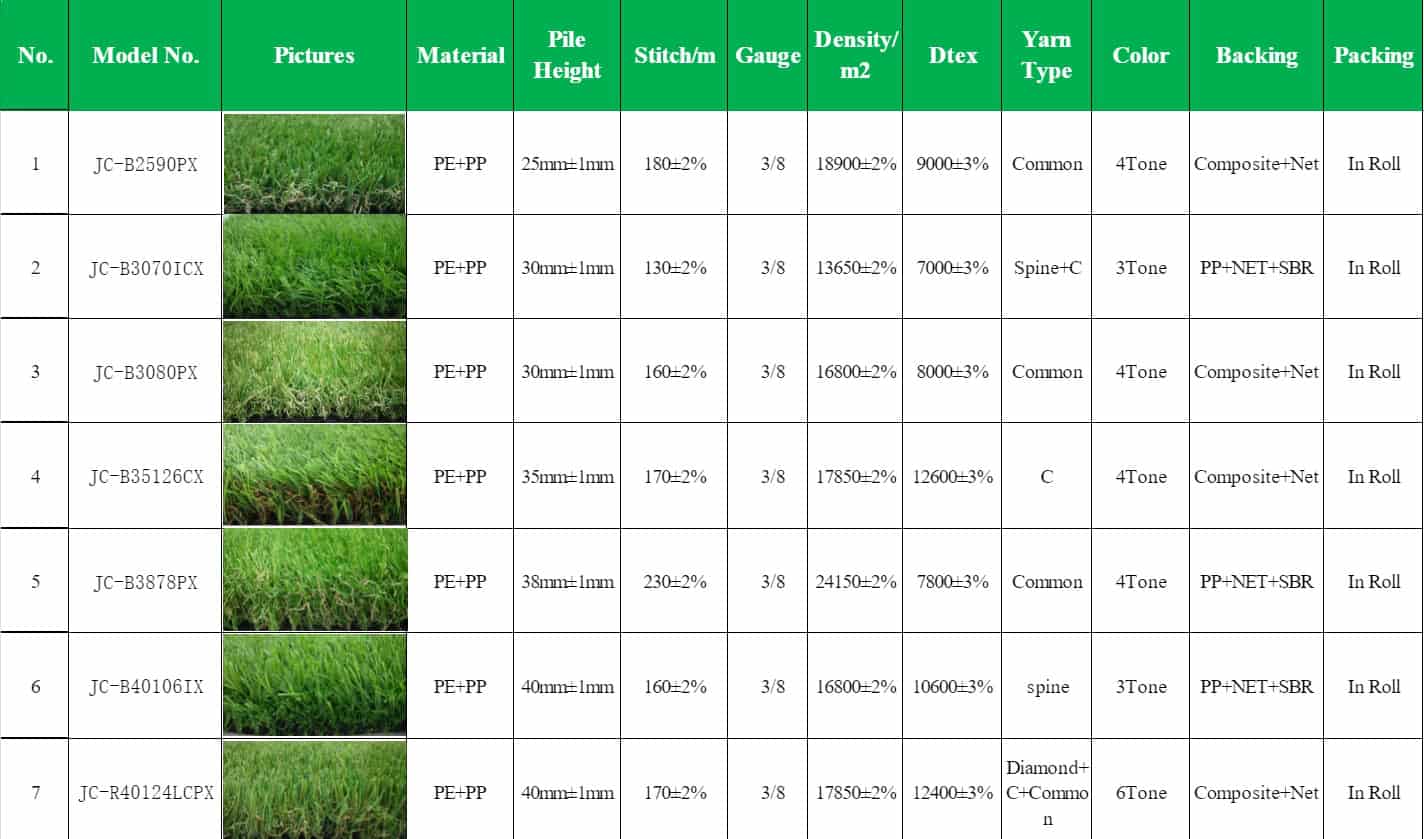Still smelling dog pee on your artificial turf—no matter how much you rinse or scrub? You’re not alone. This guide shows you exactly how to clean it properly, eliminate the odor, and stop it from coming back for good.
Built on our years of real-world experience supporting pet turf owners, you’ll learn how to clean dog urine step by step, choose the right products, avoid common mistakes, understand why odor builds up, whether urine can damage your turf, and how to prevent the smell from coming back with a smart maintenance routine.
If you’re tired of wasting time and money on solutions that don’t last, this is the fix that does—trusted by real dog owners, tested in real turf conditions, and ready to make your lawn smell fresh again.
How to Clean Dog Urine from Artificial Grass
Cleaning dog urine from artificial grass takes more than just a quick rinse. To truly remove odors and avoid long-term damage, each step matters. In this section, we’ll walk you through a complete cleaning process—from the moment your dog pees to the final rinse. You’ll learn when to act, what to use, and how often to repeat it. Here’s how to do it right:
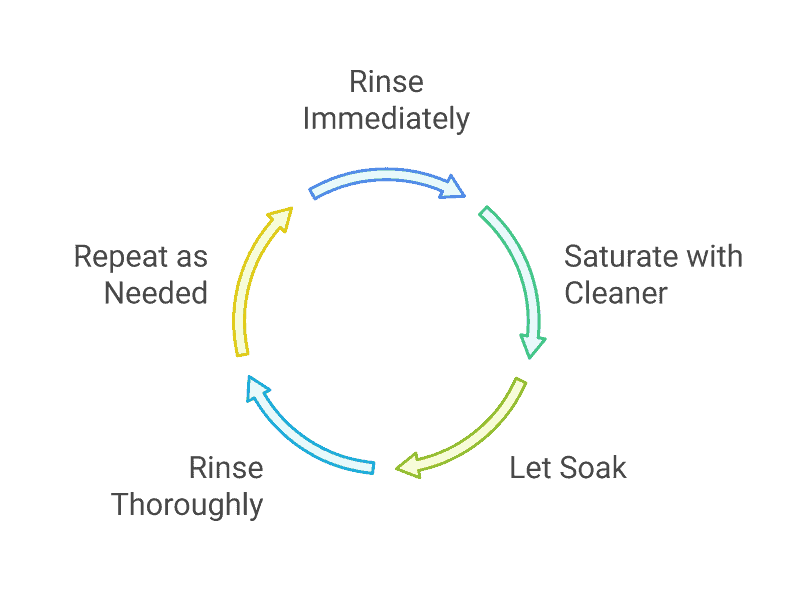
Step 1: Rinse the Area Immediately After Your Dog Pees
The sooner you rinse, the better. Urine can quickly soak through turf fibers and into the infill layer, where it starts to break down and smell.
Use a garden hose with decent pressure, not just a trickle. Focus on the spots where your dog tends to pee. If you catch it fresh, a solid 30-second rinse is often enough to prevent most odors from forming. Waiting even a few hours can make cleanup harder and less effective.
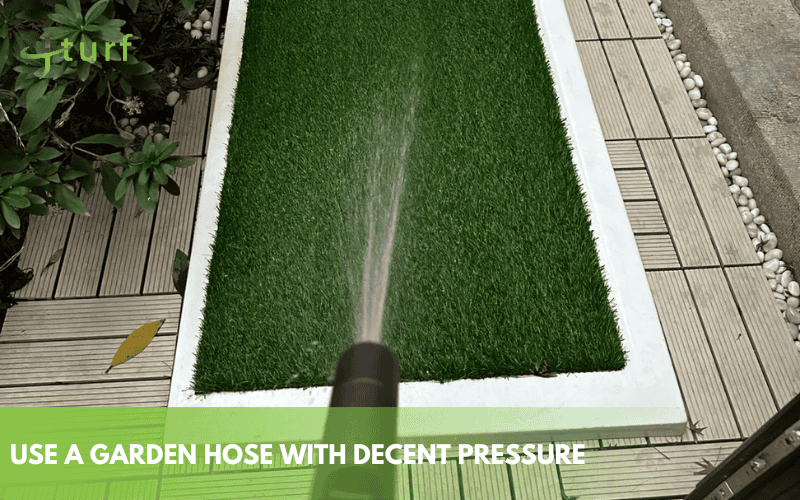
Step 2: Saturate the Turf with a Cleaning Solution
Rinsing helps, but it doesn’t remove the chemical compounds that cause odor. That’s where cleaning solutions come in.
You have two options here: enzyme-based cleaners or natural mixes like vinegar and water. Enzymes are ideal because they break down the uric acid crystals that water can’t touch. Make sure to soak the area, not just spray lightly. A proper saturation means the cleaner can reach the backing and infill where urine tends to linger.
Mix your product exactly as the label recommends. For vinegar, a 1:1 ratio with water is usually safe for synthetic turf.
Step 3: Let the Cleaner Sit and Soak In
Don’t rush the process. After applying your cleaning solution, let it sit for at least 15 to 30 minutes. This allows the active agents to break down the odor molecules fully.
In hot or dry climates, shade the area or add a second light spray after 10 minutes to prevent early evaporation.
Step 4: Rinse Again Thoroughly
Once the cleaner has done its job, rinse the area again—this time even more thoroughly than before.
You’re not just washing away the cleaner—you’re flushing out all the urine residue and broken-down compounds. If you used baking soda or powder-based cleaners, make sure no residue remains, as this can leave a visible film on your turf.
Step 5: Repeat as Needed Based on Use and Weather
If your dog uses the turf daily, a light rinse every day and a full cleaning once a week is a good rule of thumb. In hotter months or if you have multiple dogs, you may need to clean more frequently.
Watch (and smell) the turf. If odors return sooner, your cleaning cycle may need to be tighter. Prevention through consistency is far easier than fixing a full-blown smell problem.
Beyond the routine, choosing the right method matters. Over the years, we’ve worked closely with hundreds of pet owners using artificial turf in a wide range of climates and living situations. Many of them have generously shared their real-world cleaning routines with us—what worked, what didn’t, and under what conditions.
To help you make informed, practical choices, we’ve compiled the most effective methods our customers rely on to control dog urine odor on synthetic grass. Whether you’re dealing with hot weather, multiple dogs, or tough stains, this table offers a quick comparison of approaches that have proven successful in real-life turf environments.
| Method | How It’s Used | User Feedback | Conditions Where It Worked |
| Odormute (enzyme powder) | Mixed with water (1/4 cup per gallon), sprayed with hose sprayer or watering can, allowed to soak before rinsing. | Widely praised for long-lasting odor removal; considered the most reliable solution by many in hot, dry regions. | Hot, dry climates like Arizona; turf with decent drainage. |
| Uricide (hose-end sprayer) | Sprayed multiple times in first week, then weekly in summer; saturates deeply through turf layers. | Trusted by pet owners with persistent odor problems; especially effective where surface cleaners failed. | Thick turf layers, older urine buildup, warm seasons. |
| Thornell K.O.E. (Kennel Odor Eliminator) | Diluted with water and applied using a sprayer or watering can. Let sit for 20–30 minutes before rinsing thoroughly. | Highly praised by turf owners with large dogs and severe odor issues; often cited as the only product that worked after many trials. | Small backyards with big dogs; turf with long-term odor buildup; veterinary-grade applications. |
| Baking Soda + Vinegar | Baking soda spread on turf, brushed in, then sprayed with 1:1 vinegar and water; rinsed after fizzing. | Considered a reliable, natural method when used regularly; appreciated for its affordability and simplicity. | Homes with multiple dogs; turf with sandy infill or moderate use. |
| Apple Cider Vinegar + Baking Soda (deep soak) | Baking soda spread and broomed into turf base, left to sit for about an hour, then flushed with high-concentration apple cider vinegar via hose-end sprayer; best done before expected rainfall. | Received strong approval for deep odor removal in natural turf setups; praised for being cost-effective, safe, and non-chemical. | Medium to large turf areas; rainy climates; homes avoiding chemical treatments. |
| Straight Vinegar Spray | Applied undiluted and lightly rinsed; repeated in sunny weather. | Offered moderate relief when used repeatedly in sun-exposed areas; typically used as a supplementary measure in hot climates. | Hot weather areas like Florida Keys. |
| Upgraded Infill (Envirofill, ZeoFill) | Replacing basic sand or rubber pellets with antimicrobial infill that neutralizes ammonia. | Reported to significantly reduce odors over time; most effective when paired with improved drainage systems. | Poor-draining turf systems; long-term turf owners. |
| Electric Turf Broom + Infill Refresh | Used after baking soda treatment; helps restore infill distribution and dry turf faster. | Helps prolong turf freshness and eliminate uneven buildup; especially useful in high-traffic areas. | Turf with uneven infill or heavy foot traffic. |
| SA8 Laundry Powder | Diluted with water, poured generously, left overnight, rinsed with rain or hose. | Praised for removing urine buildup effectively on mats and turf; favored by users with allergy-sensitive pets due to its gentle formulation. | When pets had skin sensitivity; enclosed yards. |
| Happy Dog Odor Eliminator | Spray-on product provided by turf installer (Envirofill brand). | Reported effective when used alongside Envirofill systems; works best as part of a matched turf-infill solution recommended by some turf installers. | Homes with Envirofill green sand systems. |
These recommendations are based on years of hands-on experience supporting Jcturf’s customers in real-life environments. While every yard is different, the methods above reflect what consistently works—and what our team stands behind.
Best Products to Remove Dog Urine Smell from Artificial Grass
Struggling with dog urine smell on artificial grass? The right turf deodorizer can make all the difference. Below, we break down three of the most effective odor removers for synthetic turf: Odormute enzyme powder, Uricide hose-end cleaner, and Thornell K.O.E. veterinary-grade neutralizer—including how they work and when to use each.
Odormute – Enzyme Powder That Actually Works
Odormute is an enzyme-based powder that you mix with water. Unlike many surface sprays, this formula penetrates deeper and breaks down the urine compounds at the root—uric acid crystals and ammonia.
Users consistently report success with it on turf, especially in hot climates where smells get worse. It’s pet-safe when used correctly, and it works not only on turf but also on concrete, wood, and even indoor surfaces.
How to use: Mix according to the instructions (usually ¼ cup per gallon), and apply generously with a garden sprayer or watering can. For best results, use it after rinsing and allow it to soak in before a second rinse.
Uricide – Hose-End Cleaner for Turf and Soil Layers
Uricide is a liquid cleaner that connects directly to your garden hose. It’s made specifically for artificial grass and is designed to soak through the turf, backing, and into the infill or ground layer.
This deep penetration is what sets it apart. It doesn’t just mask odor; it targets bacteria and odor compounds below the surface.
How to use: Hook the bottle to your hose and spray evenly across the turf. Repeat 2–3 times in the first week if the smells are strong. After that, switch to a maintenance schedule (1x per week during warm seasons).
Thornell K.O.E. – Professional Grade Odor Neutralizer
Thornell’s Kennel Odor Eliminator (K.O.E.) is a professional-grade cleaner used in shelters and vet clinics. It’s highly concentrated and known for neutralizing strong animal odors, not just masking them.
This is a great choice for households with large dogs or multiple pets, especially if other products haven’t worked.How to use: Dilute as directed, then apply using a sprayer or watering can. Let it sit for 20–30 minutes before rinsing. Safe for pets, but don’t let them back on the turf until it’s fully dry.
Mistakes to Avoid When Cleaning Dog Urine from Fake Grass
Still smelling urine even after cleaning? Chances are, you’re making one of these common mistakes. Fixing them often makes a bigger difference than switching products. Here’s what to avoid—and what to do instead:
- Using Too Little Water or Cleaner
Light misting doesn’t work. Urine sinks deep into the infill and base—unless you fully soak the area, the smell stays trapped. Always saturate thoroughly, especially if odors keep coming back. - Not Rinsing After Cleaning
Cleaner residue invites new bacteria. Even enzyme products need a final rinse to wash away broken-down compounds. Flush thoroughly after every treatment. - Ignoring the Layers Below
The odor often hides beneath the surface. Spraying just the blades isn’t enough. Choose cleaners like Odormute or Uricide that reach the infill and base layers—and apply enough to get there. - Waiting Too Long to Clean
The longer it sits, the worse it gets. Urine dries into stubborn crystals in just a few hours. Clean the area within 30 minutes whenever possible. - Using Harsh Chemicals
Bleach and ammonia can damage turf fibers and harm pets—without removing odor at the source. Stick with pet-safe enzyme or vinegar-based cleaners. - Skipping Routine Maintenance
One cleaning isn’t enough. Daily rinsing and weekly deep cleaning (especially in hot months or multi-dog homes) is the key to long-term odor control.
Why Dog Urine Smell Builds Up on Artificial Grass?
Dog urine odor builds up on artificial grass because synthetic turf doesn’t absorb or break down waste like natural ground. Instead, urine drains through the blades and settles in the infill, backing, or base layer—where it often lingers, especially if drainage is poor or cleaning is inconsistent.
As urine dries, it forms uric acid crystals that cling to the turf system and resist simple rinsing. These compounds become reactivated by heat or humidity, which is why odor often returns during warm weather, even after you’ve cleaned the area.
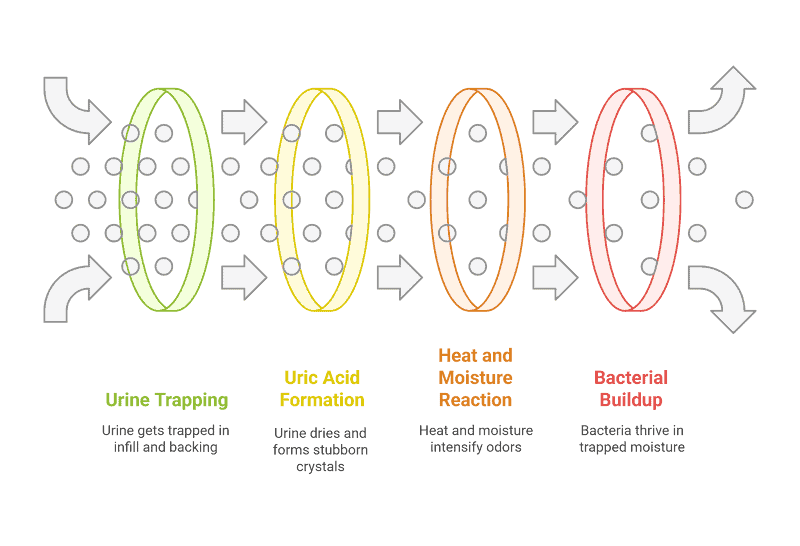
Many turf systems labeled as “pet-friendly” still use basic silica infill or low-permeability backings. These materials trap moisture, slow down drying, and create the ideal environment for bacterial growth—amplifying odor over time.
Improper maintenance also plays a major role. Skipping daily rinses or relying on light surface sprays allows small urine residues to accumulate deep in the turf. In multi-dog households or hot climates, this buildup happens faster than most people expect.
In short, artificial grass traps odor because it lacks the natural breakdown process of soil. Without fast drainage, deep cleaning, and a consistent routine, even a well-installed turf system can quickly develop persistent urine smell.
Does Dog Urine Damage Artificial Grass?
Dog urine doesn’t immediately damage artificial grass, but if left uncleaned, it can cause long-term deterioration—especially in the layers beneath the surface.
The turf blades themselves are usually safe, but the system as a whole can be affected over time.
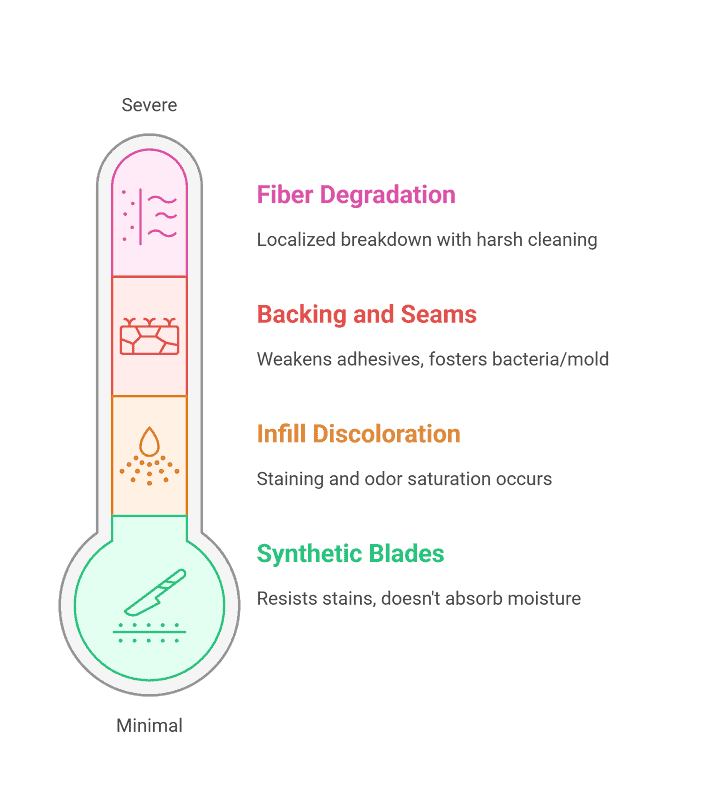
Most turf fibers are made from polyethylene or similar plastics that resist staining and don’t absorb moisture. However, repeated urine exposure can discolor the infill—especially if it’s light-colored sand or low-grade rubber. These stains are often permanent and can lock in odors even after deep cleaning.
Backing layers and seams are more vulnerable. In areas with poor drainage, trapped moisture from urine can soften adhesives, loosen seams, or degrade the backing over time. This is especially common in hot, humid climates where evaporation is slow and bacterial growth is high.
In rare cases, long-term exposure to acidic urine—combined with harsh cleaners like bleach—can weaken or degrade low-quality turf fibers in specific areas.
In short, while artificial grass won’t “burn” like natural lawns, neglecting proper cleaning and maintenance can shorten its lifespan and lead to visible wear, staining, or odor-retaining damage over time.
How to Prevent Dog Urine Smell from Coming Back on Artificial Grass
To prevent dog urine smell from returning on artificial grass, you need more than just a good cleaner—you need the right turf setup and maintenance strategy. This section outlines three key methods that work long-term: improving turf drainage, choosing odor-resistant infill, and setting a consistent cleaning schedule.
Improve Drainage to Flush Urine Out Effectively
Poor drainage is the most common reason urine smell lingers. If liquid can’t escape quickly, it pools in the backing or underlayment, creating a perfect environment for odor-causing bacteria.
Choose a turf system with a permeable backing and make sure the base layer beneath it has a proper slope. Crushed granite or class II road base often works better than plain sand or compacted soil. After installation, test drainage by dumping a bucket of water and watching how fast it disappears—slow absorption usually means a drainage issue.
Use the Right Infill to Prevent Odor Buildup
Not all infills are equal. Standard silica sand or rubber pellets tend to trap urine and odors over time. They also dry slowly, which makes things worse in hot weather.
For pet areas, use antimicrobial infills. These are designed to resist bacterial growth and help neutralize urine smell. Some even absorb ammonia and release it slowly to avoid sharp odor spikes.
Also, avoid using too much infill. A thick layer holds more liquid and makes rinsing less effective.
Set a Regular Turf Cleaning Schedule
Even with perfect drainage and premium infill, regular cleaning is what keeps odors under control.
Rinse the turf briefly every day if your dog uses it often. Once a week, do a deeper clean with an enzyme cleaner or a vinegar-based mix. During hotter months, increase the frequency to every 3–4 days.
Don’t wait until you smell something. Preventive maintenance is far more effective—and far less frustrating—than chasing a smell after it sets in.
A Clean Turf Starts With Smart Habits
Keeping artificial grass clean from dog urine isn’t just about finding the right product—it’s about building a simple, sustainable habit. The truth is, no cleaner can fully solve the problem if the turf doesn’t drain well, if the smell is ignored for too long, or if routines break down in hot weather.
The most common mistake we see isn’t picking the wrong enzyme—it’s thinking that a one-time spray will fix a long-term problem. Odor control for synthetic turf comes down to a few smart moves, done consistently: rinse fast, clean deep, use the right infill, and don’t skip maintenance just because the lawn “looks” clean.
If you’ve made it this far, you already know what works and what doesn’t. Now it’s about choosing what fits your yard, your dog, and your daily life—and sticking with it. That’s how clean, odor-free turf becomes your new normal, not just a lucky weekend win.
Looking for a Pet-Friendly Turf That Doesn’t Smell in the First Place?
If you’ve tried every cleaning method and your turf still smells, it might not be you—it might be the turf. Not all artificial grass is made with pets in mind. Some absorb moisture, trap odors, and need constant deep cleaning to stay usable.At Jcturf, we design and manufacture pet turf that skips the stress. Our infill-free, fast-draining grass is built to stay dry, clean, and odor-free—even with daily use. No puddles. No lingering smells. Just soft, paw-safe comfort and easy rinse-off maintenance.If you’re ready to stop fighting odors and start fresh, see our pet-friendly turf, designed for real dogs, real messes, and real life.
